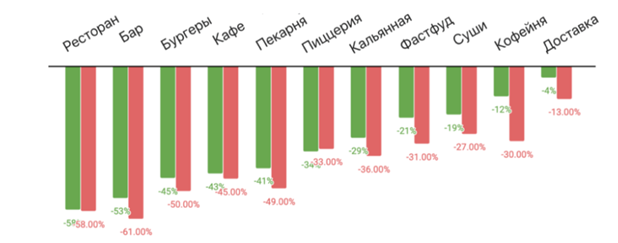How HoReCa market will develop. Forecasts of experts
HoReCa market is one of the most dynamic in Ukraine. Experts of ecosystem for women WE ARE tell about the impact of Covid-19, prospects and ways of the market development.
HoReCa market in figures
Local market of eating out is rather active and highly competitive in Ukraine. According to the data of the State Statistics Service of Ukraine, in 2018 there were 52.7 k eating establishments in Ukraine (fast-food restaurants, cafes, bars, restaurants, etc.) Despite this, the concentration of customers in local facilities is rather high in comparison with similar European facilities. For example, in Kyiv there are approximately 30 persons per seat in the public eating facilities, whereas in Europe - only 8 persons (data of Pro-Consulting). It indicates the prospects for development of this sector in Ukraine.
| Structure of eating-out market in Ukraine by segment in 2018 (considering the share of individual entrepreneurs), % Restaurants, cafes – 52,2% Catering – 23,6% Petrol stations – 20,3% Hotels – 3,9% Source: State Statistics Service of Ukraine |
HoReCa market was one of the markets that were affected the most during the lockdown. April 2020 was the hardest month for restaurants, bars and cafes. According to the data of the research carried out by restaurants automation company Poster, earnings of eating establishments for that month constituted only 26% of earnings in February. As of May 31, only 70% of public eating establishments resumed their activities in Ukraine. Average earnings after the opening of summer terraces constituted 50% of the pre-crisis figures.
| Earnings of public eating facilities in February-May 2020, % February – 100 March – 69 April – 26 May – 50 Earnings for February 2020 is considered as 100% earnings The analytics is prepared by Poster company on the basis of the data on the sales of 4k establishments in Ukraine. |
Average loss of turnover for the period 24.02- 31.05. 2020
The comparative chart includes establishments that operated during the quarantine. Turnover losses for four weeks of March-April in comparison with four weeks before the quarantine are marked in red, whereas green color marks losses for 4 weeks of April-May in comparison with four weeks before the quarantine.

The analytics is prepared by Poster Company based on the data on the sales of 4k establishments in Ukraine
Marketing research shows that the presence of café or restaurant in a hotel increases its profits by 15-20%. In terms of hotel market itself, in 2018 Ukraine was in TOP-3 in the list of the most active European countries based on the number of open hotels. According to the data of the State Statistics Service of Ukraine, in 2018 there were 4719 temporary accommodation establishments (hotels, hostels etc.) in Ukraine, which exceeds the indicators for 2017 by 14.7%.
| Geographic structure of the Ukrainian hotels for 2018 Kyiv – 107 Lviv region – 104 Odesa region – 67 Kyiv region – 52 Dnipropetrovsk region – 52 Ivano-Frankivsk region – 46 Zakarpattia region – 42 Kharkiv region – 38 Poltava region – 31 Other – 250 Total – 789 Source: State Statistics Service of Ukraine |
About tendencies and trends
“Despite the fact that the quarantine affected the financial standing of many Ukrainians, people miss gatherings outside home, as well as delicious food, they crave for emotional experience”, notes Olena Diomina, creative marketing-strategist, branding and customer-oriented approach expert, member of operations line of ecosystem WE ARE. – “In the nearest future two types of restaurants will become popular: establishments ready to provide delivery and gastronomical restaurants where gastronomic experience may be received directly in the establishment, since during the delivery food loses its taste, form and attractiveness.”
Olena recommends owners of gastronomical restaurants to apply a creative approach to the menu development as much as possible. The more unusual and exquisite dishes are on the menu, the more the venue will attract customers.
“Abroad a chef of the restaurant, even a Michelin-starred one, often comes to the dining room to the guests. Chefs communicate with visitors, make small presents. It also attracts people. Perhaps, Ukrainian restaurants should introduce such a practice in their establishments”, Olena Diomina advises.
Gradually big businesses that operate on other markets enter HoReCa market. For example, one of the biggest Ukrainian retailers Fozzy Group develops actively restaurant business and opens own restaurants and bread bakeries. Marketplace Rozetka launched their first café. Olena Diomina notes: “It is not unlikely that other big businesses will also explore this niche and will not only open own eating establishments, but will also start to sell franchises.”
Kseniia Shyshenok, co-founder of consulting company “Quality guaranteed” and strategic planning expert of WE ARE, notes that dark kitchen format is becoming more and more popular in Ukraine. These establishments work only for delivery of ready-made food. Their benefits are the optimization of costs for lease and staff (waiters, administrators, baristas etc.). Even the biggest companies enter dark kitchen market.
“Tendencies indicate that people will buy ready-made or semiprepared food, semi-products that may be cooked at home”, - emphasizes Kseniia Shyshenok. So, if you are thinking about the development of semi-products business, there is merit in it, but remember that the quality of products and service must be on a proper level.
“Restaurants begin also to sell frozen products. For example, Ukrainian cuisine restaurant O’Panas located in the Taras Shevchenko park in Kyiv began to sell frozen varenyky. They are obviously more expensive than similar products from the supermarkets, but people willingly buy them, because they know that this is restaurant food of the respective quality”, Olena Diomina outlines.
Olesia Stoiko, co-owner of PR-agency PointeR, communication expert of WE ARE, shares information about the seafood shop: “They decided to close shop for the period of the quarantine and switched to the products delivery. Communication with the customers was carried out via the chat in Viber. Their products were of high quality and the pool of loyal customers was eager to go from offline to online. The shop offered two options – order delivery and pick up. Customers were not allowed to write in the chat regarding organizational issues, but the administration encouraged them to leave reviews (both positive and negative). Seafood was of high quality and thus the reviews were always positive. Some customers even sent the pictures of their dishes. It was nearly the best bait and recommendation for new customers.”
If you are still considering whether to enter the HoReCa business now, Olesia Stoiko advises to think carefully. If earlier, according to statistics, the average “life cycle” of a small restaurant was about three years, today such establishments can “die”very quickly. At least because they miscalculated the place where the bar or coffee shop will be located. If we talk about large chains of food establishments, they require considerable investment,” explains the expert.
Kseniia Shyshenko agrees with Olesia and adds: “We should remember that HoReCa is a groceries business. And groceries spoil quickly. So to be successful in it, you need to be able to plan well and calculate to the smallest detail. Otherwise, financial losses are inevitable. Work on the concept. This factor has a significant impact both in the restaurant and hotel business. The target audience of your business, pricing policy, the list of products and services that you will offer, etc. depend on the concept.”
“It is also important to think carefully about the menu that you will offer to customers. It is difficult to impress with classic dishes, such as potatoes or simple salad. Today, pizzerias are popular, as well as seafood and Georgian cuisine. Another interesting point: analyzing the delivery market in different segments during the quarantine period, we noticed that the demand for sushi remained unchanged – did not decrease or increase. This testifies to the stability of sushi lovers,” says Kseniia.
“In times of instability, creativity is important. There will always be people who are willing to pay extra money for non-standard solutions. For example, a restaurant may offer a wine subscription with a set of cheeses that will best reveal its taste. For customers, this is an opportunity to gain a new experience by sitting comfortably at home in a chair or gathering with friends outdoors,” says Olena Diomina.
Key points
The situation with Covid 19 pushed HoReCa market to search for new formats of work, products and services. In order to keep afloat and develop your business successfully, Iryna Kosareva, the managing partner of Rekursiia audit firm, the mentor in tax issues of WE ARE advises to take some important points into account.
Place your stake on delivery. Talk about this in all communication channels.
Shift your business promo campaigns to online mode. Offline activities are not effective now.
Search for your business differentiation point. Think what makes it different from the competitors. Perhaps, you make a delivery within 10 minutes of ordering. Or, perhaps, some dish from your semi-finished product line gets cooked and frozen no more than one day before the customer receives it. Speak about it. Emphasize your special features.
Look for new formats and methods of collaboration. For example, if you have a coffee shop, try to arrange various master classes for children there, speaking clubs, meetups, etc.
Take care of staff safety. Remember that COVID risk is quite high.
Make an audit of business processes. Analyze where optimization and saving is possible.
Work in compliance with the law: learn regulatory legal framework well, trace the changes, comply with the rules, based on which facilities may operate. Put your documents in order. This will prevent fines, which are currently quite high, in case of audits.















